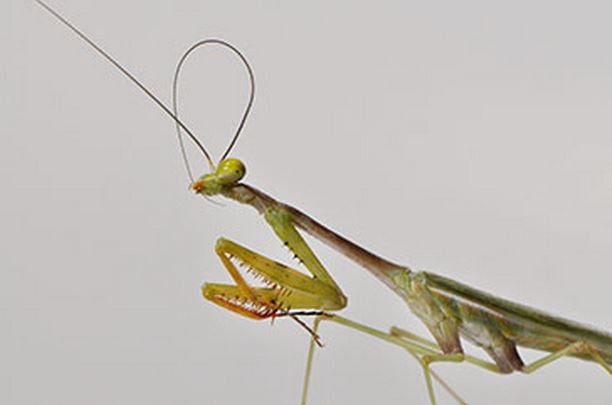The praying mantis is in total control during its jump, creating and manipulating angular momentum at spectacular speeds to guide its body for precise landings, researchers from the Universities of Cambridge and Bristol discovered in a new study.
The study has been published in the academic journal Current Biology (citation below).
High-speed videos showed that, unlike other small jumping insects, juvenile praying mantises do not spin out of control in the air.
The smaller you are, the more difficult it is to avoid spinning out of control when you leap into the air. Tiny errors in propulsive force relative to the centre of mass result in grasshoppers, leafhoppers, fleas and other jumping insects spinning uncontrollably in the air during a jump.

During the leap mantises balance out twists and rotations.
Until this study, scientists had hypothesized that all small insects were unable to control their movements, and spun unpredictably, with many frequent landings.
After analyzing a series of video footages of wingless, juvenile praying mantises, the researchers found they use a technique that actually harnesses the spinning motion, which enables them to jump accurately at the same time as repositioning their body mid-air to match their target landing spot – all within less than one-tenth of a second.
Mantises jumped onto a rod with amazing precision
The mantises sat on a platform and jumped to a thin black rod the researchers held some distance away.
During their jumps, the praying mantises rotated their legs and abdomen at the same time, yet in several directions – rotating clockwise and anti-clockwise while in mid-air – to control their spin.
Their body movements allowed them to position themselves precisely with their targeted landing spot.
They did all this in less time that it takes a human eye to blink – within about 80 milliseconds (0.08 of a second).
Initially, the scientists wondered whether the mantis had simply developed a way of mitigating the natural spin that generally occurs when small insects jump at speed.
Mantis deliberately controls spin
When they studied the jump in slow motion more carefully, they realized that the mantis intentionally controlled spin into its jump during take-off, while in the air and when it fell to its target landing spot.
The research team analyzed 281 slow-motion videos of 58 juvenile praying mantises jumping to their target. They worked out the intricate mechanics used by the insects to land the right way up and right on target virtually every time.

The praying mantis’ jump lasts 0.08 of a second from take-off to landing. (Image Credit: Professor Malcolm Burrows, University of Cambridge)
Author Professor Malcolm Burrows from Cambridge University’s Department of Zoology, who carried out the research with Dr Gregory Sutton from Bristol University, said:
“We had assumed spin was bad, but we were wrong – juvenile mantises deliberately create spin and harness it in mid-air to rotate their bodies to land on a target.”
“As far as we can tell, these insects are controlling every step of the jump. There is no uncontrolled step followed by compensation, which is what we initially thought.”
When the landing spot was placed closer, the mantises spun themselves twice as rapidly to make sure their bodies were parallel with the target (the rod) when they landed so they could grasp it.
“The mantis gives itself an amount of angular momentum at take-off and then distributes this momentum while in mid-air: a certain amount in the front leg at one point; a certain amount in the abdomen at another – which both stabilise the body and shift its orientation, allowing it to reach the target at the right angle to grab on.”
The research team glued segments of the mantis’ abdomen together to see what would happen if it could not control its spin. They expected it to spin out of control.
They were amazed to find that its accuracy when jumping was not affected at all. They were still able to reach their target, but could not rotate their bodies into the right position and crashed headlong onto the target landing spot and bounced off.
The researchers say they want to find out how the mantis manages to achieve its mid-air acrobatics at such incredible speeds.
Prof. Burrows said:
“We can see the mantis performs a scanning movement with its head before a jump. Is it predicting everything in advance or does it make corrections at lightning speed as it goes through the jump? We don’t know the answer between these extreme possibilities.”
Dr. Sutton:
“We now have a good understanding of the physics and biomechanics of these precise aerial acrobatics. But because the movements are so quick, we need to understand the role the brain is playing in their control once the movements are underway.”
Dr. Sutton believes robotic researchers could learn lessons from young praying mantises. “For small robots, flying is energetically expensive, and walking is slow. Jumping makes sense – but controlling the spin in jumping robots is an almost intractable problem. The juvenile mantis is a natural example of a mechanical set-up that could solve this,” he said.
Citation: “Mantises Exchange Angular Momentum between Three Rotating Body Parts to Jump Precisely to Targets,” Malcolm Burrows, Darron A. Cullen, Marina Dorosenko and Gregory P. Sutton. Current Biology. DOI: http://dx.doi.org/10.1016/j.cub.2015.01.054.
Video – Praying Mantis Acrobatics
